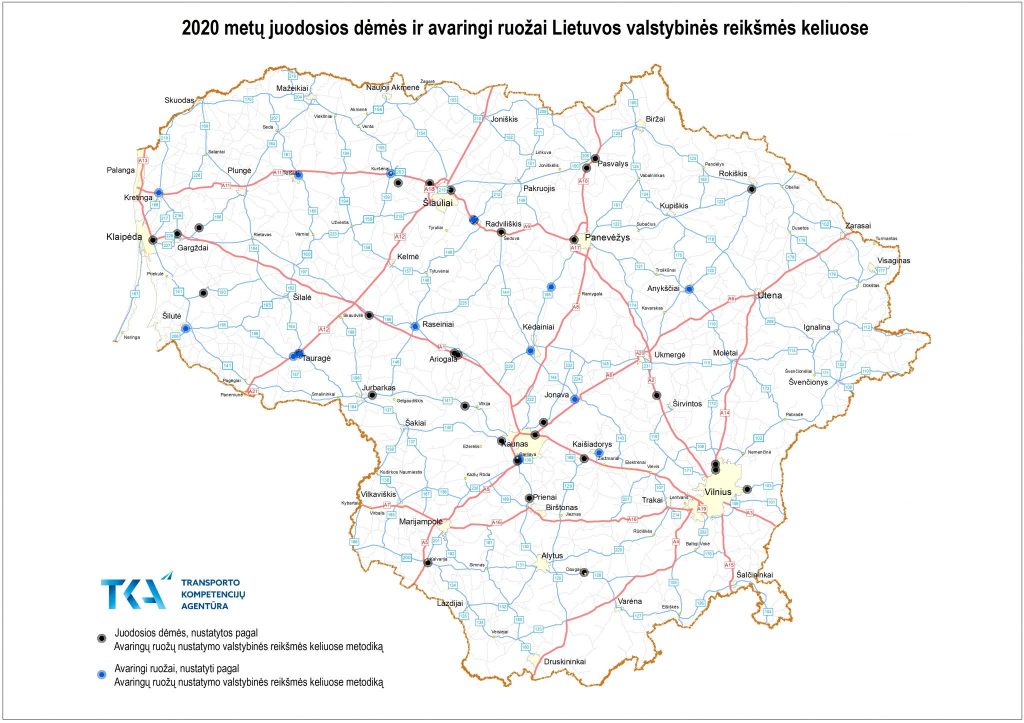The Transport Competence Agency compiled a 2020 map of “Black Spots” of national importance on roads – this year, 31 spots are marked on it, that is, 82 percent. more than last year, when there were 17. According to experts, compared to 2019, 5 spots disappeared, but 19 new spots appeared, and 7 spots changed their place.
“Black spots” are formed in those places where 4 or more traffic accidents in which people are injured or killed are recorded on a specific road section within 4 years. Analyzing the events, we found that in these places 60 percent collisions, 14 percent of all events. – pedestrian crossings, 11 percent. – overturns”, says Evaldas Morkūnas, head of the Transport Services Department of the Transport Competence Agency.
He notes that the increase in the number of “Black Spots” in the country is directly related to the increase in the number of traffic accidents during the year – it rose by 12.4 percent.
The map also marks dangerous road sections – that is, those sections where more accidents are observed. Compared to last year, their number increased by 140 percent.
The map of “black spots” is drawn up once a year. After that, the Directorate of Motor Roads of Lithuania conducts detailed studies and selects specific engineering measures that increase traffic safety.
Traffic safety experts present a list of “Black Spots” and urge drivers to be careful in these places and follow not only all traffic rules, but also safe traffic recommendations.
“Black spots” of roads of national significance in Lithuania
| Road no. |
Road name |
Beginning of the section, km |
End of section, km |
2016-2019 |
| events |
Died |
Injured |
| A1 |
Vilnius-Kaunas-Klaipėda |
94,948 |
95,000 |
4 |
0 |
4 |
| A1 |
Vilnius-Kaunas-Klaipėda |
150,000 |
150,592 |
5 |
1 |
8 |
| A1 |
Vilnius-Kaunas-Klaipėda |
151,980 |
152,300 |
4 |
0 |
4 |
| A1 |
Vilnius-Kaunas-Klaipėda |
195,095 |
195,400 |
4 |
1 |
4 |
| A1 |
Vilnius-Kaunas-Klaipėda |
304,312 |
304,800 |
7 |
2 |
10 |
| A2 |
Vilnius-Panevėžys |
54,000 |
54,200 |
4 |
1 |
4 |
| A9 |
Panevėžys-Šiauliai |
5,380 |
5,831 |
6 |
1 |
7 |
| A9 |
Panevėžys-Šiauliai |
42,212 |
42,639 |
4 |
0 |
5 |
| A9 |
Panevėžys-Šiauliai |
56,620 |
57,357 |
11 |
4 |
14 |
| A10 |
Panevėžys-Pasvalys-Riga |
34,639 |
34,820 |
4 |
2 |
4 |
| A10 |
Panevėžys-Pasvalys-Riga |
40,761 |
40,801 |
4 |
1 |
5 |
| A11 |
Šiauliai-Palanga |
7,000 |
7,308 |
4 |
0 |
4 |
| A12 |
Riga-Šiauliai-Tauragė-Kaliningrad |
154,250 |
154,993 |
8 |
1 |
7 |
| A14 |
Vilnius-Utena |
11,270 |
11,490 |
5 |
0 |
6 |
| A14 |
Vilnius-Utena |
13,990 |
14,173 |
4 |
1 |
4 |
| 103 |
Vilnius-Pollock |
15,540 |
15,893 |
4 |
1 |
3 |
| 122 |
Daugavpils-Rokiškis-Panevėžys |
23,840 |
23,900 |
4 |
0 |
8 |
| 128 |
Valkininkai str. st.-Daugai-Alytus |
25,590 |
26,045 |
4 |
3 |
7 |
| 129 |
Antakalnis-Jieznas-Alytus-Merkinė |
1,000 |
1,102 |
4 |
0 |
8 |
| 130 |
Kaunas-Prienai-Alytus |
28,950 |
29,750 |
7 |
1 |
9 |
| 131 |
Alytus-Simnas-Kalvarija |
56,024 |
56,074 |
4 |
0 |
8 |
| 140 |
Kaunas-Zapyškis-Šakiai |
11,700 |
11,836 |
4 |
0 |
4 |
| 141 |
Kaunas-Jurbarkas-Silutė-Klaipėda |
36,833 |
37,043 |
4 |
1 |
4 |
| 141 |
Kaunas-Jurbarkas-Silutė-Klaipėda |
81,760 |
81,900 |
4 |
2 |
3 |
| 166 |
Plunge-Vežaičiai |
28,369 |
28,520 |
4 |
0 |
12 |
| 193 |
Kvėdarna-Svēkšna-Saugos |
30,300 |
30,480 |
4 |
1 |
7 |
| 213 |
Alexandria-Ginkūnai |
1,485 |
1,983 |
5 |
1 |
8 |
| 216 |
Gargždai-Kretinga |
2,000 |
2,000 |
6 |
2 |
8 |
| 232 |
Vilijampolė-Žeimiai-Šeta |
11,421 |
11,800 |
4 |
0 |
7 |
| 1933 |
Garliava-Pažėrai-Veiverii |
0.100 |
1,100 |
10 |
0 |
11 |
The gray marked “black spots” were formed due to traffic accidents, the perpetrators of which were drunk and/or did not have the right to drive.




